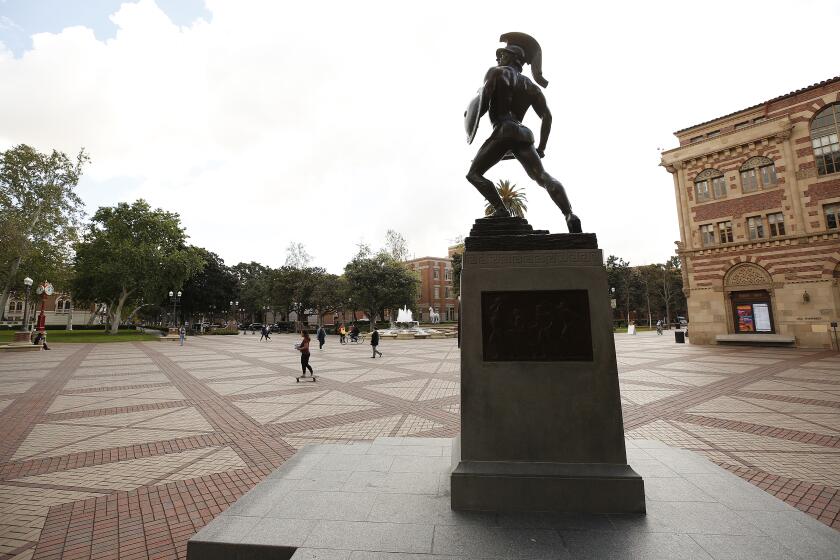How not to manage a budget crisis
Los Angeles County government does plenty of things wrong: It has struggled with overcrowded jails, dithered over how to protect the young people in its foster care system and made a mess of running Martin Luther King Jr./Drew Medical Center. But one thing it’s done right, at least compared to city government, is to manage its budget.
In recent years, the city — which has an annual budget of $6.75 billion and about 34,000 employees — has faced mounting shortfalls. It has responded by giving raises to some workers while laying off others, and adopting a revenue strategy that combines nibbling at the margins and praying for help. The county — which employs roughly 100,000 people and oversees a budget of $23 billion — has trimmed vacancies and held the line on raises. It has not furloughed or laid off a single worker. Not many organizations, public or private, can say that.
Much of the county’s relative success is attributable to fiscal discipline not shared by the city. While the county was holding down salary hikes during the mid-2000s, the city gave its workers healthy increases — many got annual bumps of 3% or 4% year after year. And given that every 1% of salary increase for city workers costs taxpayers about $15 million, those raises add up. Today, Los Angeles city government faces a projected shortfall of more than $300 million for the coming fiscal year. It is a crisis of epic proportions, and one that is largely self-inflicted.
The biggest difference between the two public entities, however, is not so much budgetary prowess as it is political reality. Until recently, the county operated without term limits, while City Council members and mayors were restricted to eight years in office. One consequence of that has been that the city has played for short-term gain while the county has adopted a longer horizon.
City Council members and the mayor, knowing that they won’t be around for long and eager to please their political base, give out raises and benefits. That pleases organized labor, which in turn supports its benefactors when they run for reelection or other offices.
At the county, supervisors have been all but immune from political pressure (they have rarely attracted more than token opposition), and the absence of term limits has meant that they are, effectively, supervisors for life. Michael D. Antonovich, who currently chairs the board, was first elected in 1980. That can make the members of the board arrogant and unresponsive, but on the budget, it’s also meant that the supervisors have an easier time saying no because they know they’ll be around when the consequences of today’s votes come due. (That may change going forward: A term limits ballot measure approved in 2002 limited the supervisors to three more terms each, so most of the board is beginning to wind down.)
Even without the sword of term limits hanging over them, the supes haven’t been entirely forward-looking. Two decades ago, an earlier generation of city leaders smartly pre-invested in the healthcare benefits of retired city workers. The result is that about half of those liabilities are covered. The county, by contrast, set aside precisely nothing, so it faces a $21-billion unfunded liability. Unless it invests money for those expenses soon, they will gobble up an increasingly significant share of county spending. That’s sadly typical of California public agencies. No thanks to its current leadership, the city’s in better shape there.
William T Fujioka, the county’s chief executive officer, says supervisors this year are facing a new set of challenges, some of them imposed by the state as it considers spinning off functions to local governments. But the county’s estimated shortfall of $280 million is manageable in its gigantic budget — straightening out its supply chain, eliminating unused phone and fax lines and asking county doctors to prescribe generic drugs already have saved tens of millions of dollars.
By contrast, city officials dither over pittances and delay their reckoning. They furiously debate whether to sell off parking structures for $50 million when they face a shortfall many times that big, and the sale would provide only a one-time fix.
City Councilman Bernard C. Parks chairs the Budget and Finance Committee and has warned of these problems for years. “We’re addicted to people,” he said in an interview last week. And well-paid ones too: 81 city officials make more than $200,000 a year.
Parks guardedly credits Mayor Antonio Villaraigosa with doing his best, but the mayor has done precious little to break that addiction. After helping make the problem worse by approving salary increases early in his term, he’s pivoted toward trying to trim the workforce, but he’s mostly moved people around, sending some employees paid by the city’s general fund to agencies such as the airport and the Department of Water and Power. Only 400 or so have actually been laid off. He has frustrated labor, which has offered ideas for savings but gotten the brush-off. Meanwhile, if Villaraigosa has a vision for what the city can afford to do and what it must learn to forgo, he hasn’t shared it.
Today, one-fourth of all city spending pays for retired workers. That’s only going to get worse unless the mayor and council act. Will they? Don’t count on it. “So many of my colleagues do not believe it’s that bad,” Parks admitted. “It’s worse than I’ve seen it in 47 years with the city.”
The councilman compares the city to an ailing patient. “All four major organs are failing,” he said. “And our debate is whether to do a manicure or a pedicure first.”
More to Read
A cure for the common opinion
Get thought-provoking perspectives with our weekly newsletter.
You may occasionally receive promotional content from the Los Angeles Times.











